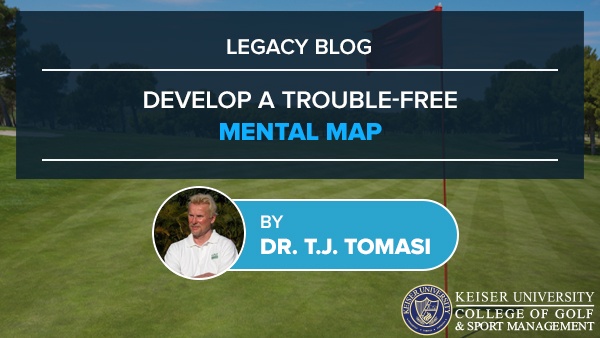Develop a Trouble-Free Mental Map

A Legacy Post by Keiser University College of Golf Senior Faculty and Director of Research Dr. T. J. Tomasi (1940-2023)
Golfers gather plenty of information about where the ball is, but not many collect enough information about where the target is. It’s ironic that in a game where hitting the target is all that matters, many golfers hardly glance at the target.
Golf Mentality
The importance of golf mentality cannot be overstated in the pursuit of success on the course. Golf is as much a mental game as it is physical, requiring focus, patience, and resilience. A strong golf mentality encompasses various aspects, including confidence in one’s abilities, the ability to stay composed under pressure, and the capacity to bounce back from setbacks. Golfers who possess a positive and resilient mindset are better equipped to navigate the challenges presented by the sport, whether it’s overcoming a bad shot, adapting to changing course conditions, or managing the mental strain of competition. Moreover, a strong golf mentality not only enhances performance but also contributes to overall enjoyment and satisfaction with the game, allowing players to approach each round with a sense of purpose and determination. As such, cultivating a robust golf mentality through practice, mindfulness, and mental training can make a significant difference in a golfer’s journey towards achieving their goals on the course.
Focus in Golf
In golf, developing a strong mental game is just as crucial as mastering the physical aspects of the sport. Focus on golf can significantly enhance a player’s performance on the course. One essential strategy is to create a mental map of the golf course before teeing off. This involves visualizing each hole in detail, including the layout, hazards, and potential challenges. By mentally rehearsing shots and strategies, players can cultivate a sense of familiarity and confidence, leading to better decision-making during gameplay. Additionally, maintaining a positive mindset, staying focused on the present moment, and managing emotions effectively are key components of mental resilience in golf. With consistent practice of mental golf techniques, players can sharpen their mental acuity, leading to improved performance and enjoyment of the game.
Mental Tips for Golf
I teach my students to treat the ball with as little respect as they can muster. Like the houses in the board game Monopoly, the ball is just a marker that tells you where you are on the course. Golf balls have no outstanding features: They all have the same weight and dimension, and they have no personality whatsoever. Yet they are so in control of the golfer’s mind that a book written a few years ago argued that everything wrong with golf starts with your golf ball. So it is that most people stare at the ball and glance at the target. I would like you to get in the habit of glancing at the ball and staring at the target. In fact, you need to practice producing a mental map of where the target is and how to get there, a map in which the ball plays only a small role – a chip in your bid for accuracy. If the ball takes a second-class position in your mental map, then it follows that the trouble on the course would too. Making a trouble-free map is what Aaron Baddeley does when he closes his eyes before taking a shot, and I have mentioned before that a 6-year-old Tiger once told his dad when asked what he thinks about before hitting, “I see where I want to hit it, Daddy.” This is as it should be because, by nature, humans are mapmakers, surveying the territory and making a virtual map – an image that prefaces a motor move.
Takeaway: My point is that running your brain correctly while solving point A to point B problems is something you already know how to do well. You can’t do any better than being human — all you have to do is block the outside interference then let it happen.

Take the time to make a mental picture then hit into it like Aaron Baddeley

When you are making your shot plan, the trouble (bunkers, water, OB, etc.) captures center stage only in the early phase of your routine. You must account for it, but it should disappear once you finish plotting your route, leaving your mental map trouble-free.
Learn more!
Want more tips? If you want to take your game to the next level, contact our team at Keiser University’s College of Golf & Sport Management today. With our dedication and experience, we can elevate your game to new heights together. Give us a call today at 888-355-4465.














